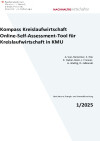Suchergebnisse
Marktentwicklung innovativer Energietechnologien – Ergebnisse aus 2023
19. Juni 2024, 10:00 – 14:00 Uhr
BMK, Festsaal (Erdgeschoß), Radetzkystraße 2, 1030 Wien
Am 19. Juni 2024 wurden die Marktzahlen des Jahres 2023 präsentiert. Dabei wurden die Trends und der Status der Marktdurchdringung von erneuerbaren Energie- und Speichertechnologien in Österreich vorgestellt.
IEA Bericht: Global Critical Minerals Outlook 2024

Der Bericht "Global Critical Minerals Outlook 2024" der Internationalen Energieagentur bietet neue mittel- und langfristige Prognosen für Angebot und Nachfrage wichtiger Rohstoffe für die Energiewende wie Lithium, Kupfer, Nickel, Kobalt, Graphit und seltene Erden.
Herausgeber: IEA
Englisch, 282 Seiten
Additive Manufacturing of Continuous Fibre Reinforced Polymers for Structural Applications (3D-CFRP)
Strategische Ziele sind die Entwicklung von neuen Materialien und Technologien für hochbelastbare Bauteile aus endlosfaserverstärkten Kunststoffverbunden im FFF (Fused Filament Fabrication)-Verfahren. Dies soll die Realisierung 3D-gedruckter Composite-Bauteile als hocheffiziente Alternative für klassisch hergestellte CFRP-Komponenten in Luft- und Raumfahrt, Automotive, Wind Energie, etc. ermöglichen.
Mechanisches Recycling von Kunststoffen: Von Abfall-Kunststoffen zu hochwertigen, spezifikationsgerechten Rezyklaten (circPLAST-mr)
Das Leitprojekt circPLAST-mr verfolgt die folgenden 4 Hauptziele: (1) Aufspüren und Erforschen bisher nicht genutzter Potentiale für das mechanische Kunststoff-Recycling, (2) Festlegung und Austestung dafür zentraler Verfahrensschritte im Labor/Pilot-Maßstab, (3) Nachweis für die öko-effiziente Marktfähigkeit erhöhter Rezyklat-Kunststoffmengen, und (4) Nachweis der Skalierbarkeit der Labor/Pilot-Verfahrensschritte auf den Produktionsmaßstab.
Stereolithographie-Materialien, Produktion und Plasma-Nachbearbeitung für langlebige Automobilanwendungen (SYMPA)
Im Projekt entwickelt ein deutsch-österreichisches Konsortium nachhaltige Materialien, Prozesse und Nachbehandlungsverfahren für den 3D-Druck (Stereolithografie) für den dauerhaften Einsatz in Automobilanwendungen. Im Fokus liegen neue Polymermaterialien, Anlagenentwicklung, Steigerung der Steifigkeiten, Festigkeiten, UV-Stabilität, Verschleißreduktion und verkürzte Prozesszeiten.
Workshopreihe „Kreislauffähiges Planen und Bauen“
23. April - 16. Mai 2024
Online & Präsenz (Wien)
Die Workshopreihe bietet in vier Modulen einen umfassenden Überblick über alle Aspekte der Kreislauffähigkeit.
2. Circular Carbon Economy Summit
12. November 2024, 9.00 – 18.00 Uhr
Palais Niederösterreich, Herrengasse 13, 1010 Wien
Diskutieren Sie mit Expert:innen aus Wirtschaft, Wissenschaft, Politik und Verwaltung die Perspektiven von zirkulärem Wirtschaften für die kohlenstoffbasierten Wertschöpfungsketten, die einen wesentlichen Beitrag zum Klimaschutz und zur Kreislaufwirtschaft erzielen sollen.
Jetzt mitmachen: Umfrage zur Kreislaufwirtschaft in der Textilbranche
Wie gelingt der Wandel zur Kreislaufwirtschaft in textilen Wertschöpfungsketten? Welche Hürden gibt es – und welche Maßnahmen wirken unterstützend? Machen Sie mit! Gesucht werden Expert:innen aus Unternehmen entlang der textilen Kette: von Faser- und Textilherstellung über Handel und Reparatur bis hin zur Verwertung von Abfällen und Sekundärressourcen.
10. Carbon Capture Forum
27. September 2024, 09:00 - 13:00 Uhr
Klima- und Energiefonds, Wien
Quo Vadis Carbon Capture? – Diskurs zum nachhaltigen Einsatz von CCU, CDR und CCS
QB3R - QS-gefertigte Hochleistungsbauteile auf Basis 100% biobasierter Rohstoffe mit hohem Reparatur- und Recyclingpotential
Das Vorhaben QB3R zielt darauf ab ein Epoxidharzsystem mit einem biobasierten Kohlenstoffanteil von 100% zu entwickeln. Das QB3R-Harz wird sich mit einer breiten Palette an Verarbeitungstechniken qualitätsgesichert zu Hochleistungsbauteilen für langlebige Sachgüter verarbeiten lassen.
Circular Carbon Economy Summit 2025
4. - 5. November 2025
Palais Niederösterreich, Herrengasse 13, 1010 Wien
Regenerative Ressourcen als Grundlage für einen zukunftsfähigen und resilienten Wirtschaftsstandort
ERFA Kreislaufwirtschaft - Regularien in der Kreislaufwirtschaft (5. Treffen)
14. Mai 2025
wird noch bekannt gegeben
Wir betrachten aktuelle rechtliche Entwicklungen - von EU-Vorgaben bis zu nationalen Regelungen -, diskutieren ihre Chancen und Herausforderungen und analysieren, wie sie als Katalysator für die Kreislaufwirtschaft dienen können.
Grüne Gase - Grüne Zukunft: Rechtliche Rahmenbedingungen und ihre Anforderungen
17. Juni 2025
Business Upper Austria - Cleantech-Cluster, Hafenstraße 47-51, Linz
Erfahren Sie, was der Clean Industrial Deal, das Erneuerbaren-Ausbau-Gesetz (EAG) und das geplante Erneuerbares-Gas-Gesetz (EGG) für Unternehmen bedeuten – mit Expert:innen-Inputs, Praxisbeispiel und Austauschmöglichkeiten.
Renewable Materials Conference 2025
22. – 24. September 2025
Siegburg bei Köln
Die Renewable Materials Conference (RMC) präsentiert führende Lösungen und Innovationen für die Substitution fossilen Kohlenstoffs durch Biomasse, CO₂-Nutzung und Recycling. Ein Highlight der Konferenz wird die Verleihung des Innovationspreises „Renewable Material of the Year 2025" sein.
Abwasser-Kreislauf. Kaskadische Verwertung der Abwasser- und organischen Reststoffströme in Gebäuden
Es wird Grundlagenforschung für ein nachhaltiges kreislauforientiertes System zur gebäudeintegrierten Verwertung von Abwasser und Speiseresten betrieben. Dieses umfasst Nährstoffrückgewinnung für ein nachhaltiges Kreislaufsystem (Erzeugung von Pflanzendünger und Biokohle), Stromproduktion für die Bedarfsdeckung (bis 15 %) von Plus-Energie-Gebäuden, sowie Nutzwassergewinnung für die Bewässerung objekteigener oder urbaner Begrünung und zur Sommerkühlung.
Kompass Kreislaufwirtschaft - Online-Self-Assessment-Tool für Kreislaufwirtschaft in KMU

Im Projekt Kreislaufwirtschaftskompass wurde ein responsives Online-Self-Assessment-Tool für Kreislaufwirtschaft in KMU entwickelt. Der Kompass Kreislaufwirtschaft fragt in innovativer Weise die wichtigsten Handlungsfelder zur Umsetzung einer effizienten Kreislaufwirtschaft für österreichische Produktionsbetriebe (Schwerpunkt KMU) in einem Online-Fragebogen ab und ermöglicht auf Basis eines theoriebasierten Bewertungsschemas den Betrieben, mit vertretbarem Aufwand ihre Circular Economy Readiness einzustufen.
Schriftenreihe
1/2025
A. Van-Hametner, S. Eisl, K. Huber-Heim, J. Fresner, G. Gluttig, D. Jablonski Berichte aus Energie- und Umweltforschung 1/
Herausgeber: BMK
Deutsch, 36 Seiten
Downloads zur Publikation
Bio-based adhesives for floor coverings (BioGlue)
Das BioGlue-Projekt untersucht die Möglichkeit, maßgeschneiderte sogenannte „Bioklebestoffe“ für Boden- und Wandverkleidungen im Innenbereich herzustellen. Ziel ist es, traditionell verwendete, nicht erneuerbare, fossile Klebstoffe durch nachwachsende Rohstoffe, nämlich Lignin, zu ersetzen. Diese „Bioklebestoffe“ werden unter Einsatz umweltfreundlicher Enzym-basierter Technologien entwickelt.
Sustainable Binders / Nachhaltige Bindemittel für Spanplatten (SUSBIND)
Das SUSBIND-Projekt entwickelt, produziert und testet biobasierte Bindemittel als Alternative zu den derzeit für Holzwerkstoffplatten in der Möbelprodukten verwendeten Bindemitteln auf fossiler Basis. SUSBIND deckt die gesamte Wertschöpfungskette von Rohstoffen bis zur Pilotproduktion und Validierung durch relevante Partner aus Forschung, Industrie und KMU ab. Dem Projektgremium gehören auch führende Möbelhersteller und Einzelhändler an.
Nachhaltige, multifunktionale Düngemittel für die Versorgung von Pflanzen mit Phosphaten und Eisen (SUSFERT)
Entwickelt werden nachhaltige, multifunktionale Dünger für die Pflanzenversorgung mit Phosphor und Eisen, um konventionelle, fossile Produkte ersetzen zu können. Die SUSFERT-Dünger basieren auf Neben- und Abfallprodukten mehrerer Industrien und stärken so die Kreislaufwirtschaft.
BioABC – Biologische Umwandlung von Abfall zu Butanol mit CO2 Fixierung
Im Projekt Bio-ABC soll ein zweistufiger Prozess für die Fixierung von CO2 entwickelt werden. Im ersten Schritt soll das fixierte CO2 in eine Speicherchemikalie (Essigsäure) umgewandelt werden, die dann in einem weiteren zweiten Prozessschritt zu einem Alkohol umgewandelt wird. Durch das zweistufige System bietet diese Lösung ein hohes Maß an Flexibilität und Weiterentwicklungsmöglichkeiten.
